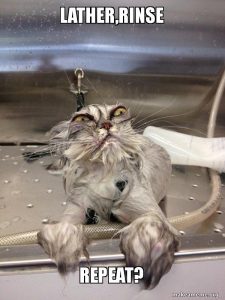During the second F2F session for Cohort 21 I came in with the idea that my action plan would revolve somewhere around the idea of Creating a Culture of Grit.
By using the design process to hone in deeper into my action plan, I felt that the process turned out to be more cyclical than I had expected. I started off with the idea that I wanted to build grit in the entire community at my school this year. After reflecting about some of my problems and challenges I started to break down these goals into much smaller, seemingly unrelated goals such as “supporting student balance between content heavy courses and extracurriculars” and “providing students with hope and motivation”. While discussing it with my partner Dan, I realized that these smaller goals that I thought were unrelated and steering me away from grit, really fall under the umbrella of building grit.
 While considering the user of my objective I considered a student of mine, let’s call him Bologna (not his real name) . Bologna is a mid-high range user that strives to achieve at a high level but has a lot on his plate and is consistently disappointed in himself and his results. This is causing him to be very results-driven, looking for quick answers instead of critically evaluating course content. During the design process at F2F #2 at TYS, I came up with a list of things that I thought might help Bologna. Things such as “help him feel interested”, “providing more encouragement”, “discussing time management skills”, “inspiring curiosity”, and “providing a sense of purpose in his work”. As I started making this list, I sat back and thought, “Wait a second, all of these things would be helpful to the low and high-end users as well!” I thought that this process was really interesting because initially when I consider my low and high-end users as individuals, it is difficult for me to identify them having similar needs right off the bat. Sectioning it into three user areas and coming up with ways to address those needs, really allowed me to identify the fact that they do in fact have a number of similar needs.
While considering the user of my objective I considered a student of mine, let’s call him Bologna (not his real name) . Bologna is a mid-high range user that strives to achieve at a high level but has a lot on his plate and is consistently disappointed in himself and his results. This is causing him to be very results-driven, looking for quick answers instead of critically evaluating course content. During the design process at F2F #2 at TYS, I came up with a list of things that I thought might help Bologna. Things such as “help him feel interested”, “providing more encouragement”, “discussing time management skills”, “inspiring curiosity”, and “providing a sense of purpose in his work”. As I started making this list, I sat back and thought, “Wait a second, all of these things would be helpful to the low and high-end users as well!” I thought that this process was really interesting because initially when I consider my low and high-end users as individuals, it is difficult for me to identify them having similar needs right off the bat. Sectioning it into three user areas and coming up with ways to address those needs, really allowed me to identify the fact that they do in fact have a number of similar needs.
Since the F2F at TYS I have started to incorporate more “student brainstorming” in my classes – through think-pair-shares, whiteboard brainstorming or class discussions based on concepts, experiments or the meanings behind terminology. This has started to create a culture of “making mistakes” in the classroom, ideally to move away from the “results-driven” mindset and more towards a growth mindset.
I have titled this post lather-rinse-repeat because for my action plan, it all starts at the idea of grit. Followed by breaking this down further, to some issues I am having specifically in my classroom. I think of a small solution to help a range of users, but ultimately I again return to grit, with the overarching goal of how I can slowly start to develop gritter lifelong learners across all my students.
Image from: https://makeameme.org/meme/latherrinse-repeat
Thanks for sharing your post-F2F reflections, @sregli! It sounds as though you’ve already begun to incorporate some of your work from that day into your daily classroom life. I am looking forward to seeing how the rest of your year shapes up with this focus.
Your mention of your high-end and low-end users sharing many of the same needs made me think of Universal Design for Learning, which (somehow!) I interacted with for the first time this spring, while taking an AQ course. The main principle of UDL is that things that we tend to do for certain individuals requiring accommodations tend to be beneficial to the whole group as well. Certainly developing grit and a growth mindset is something that all of our learners can benefit from, even if it might look different for certain users!
Bringing in student-led brainstorming techniques is a great way to allow extro-verted students a way to connect. It’s a great way to allow student voice to ring out in the classroom as well.
If you haven’t already come across his work, Kagan’s cooperative group structures are a ‘design-thinking’ style/approach to enhance collaboration. I call it the death of brain-storming because there is a structured outcome and expectations with for individual students (be they introverts or extroverts) with each of them.
Great work! I look forward to reading more!
garth.